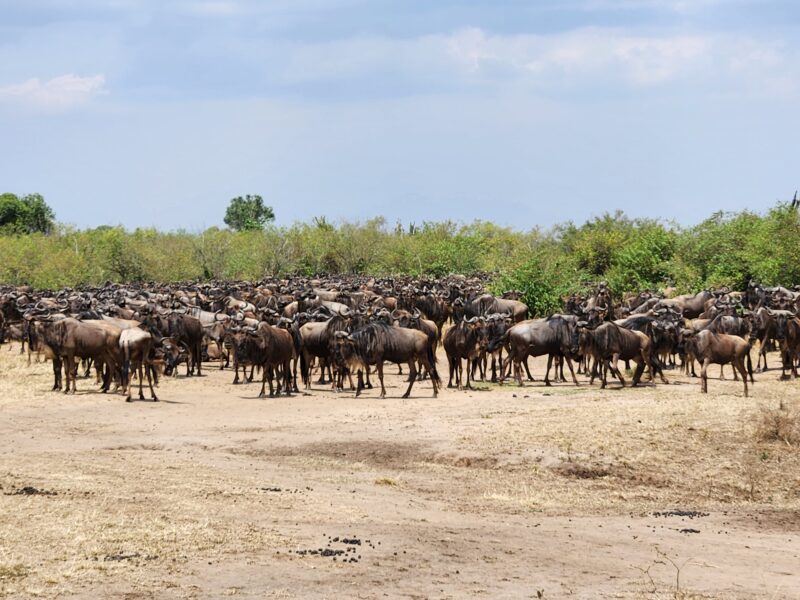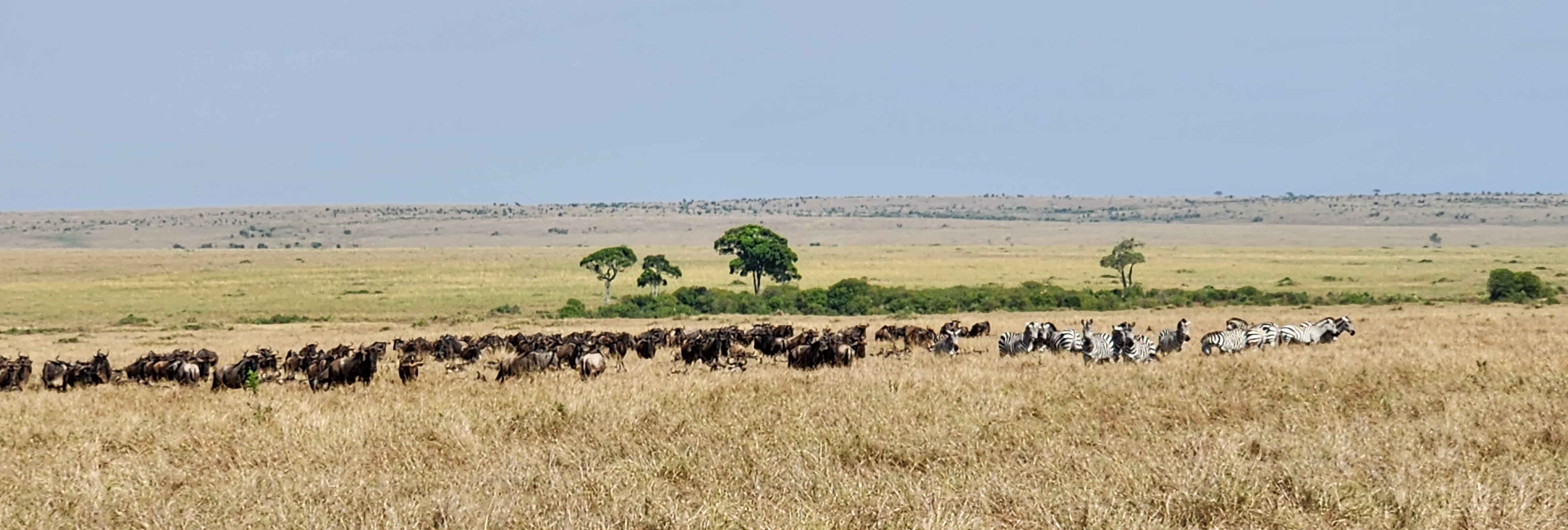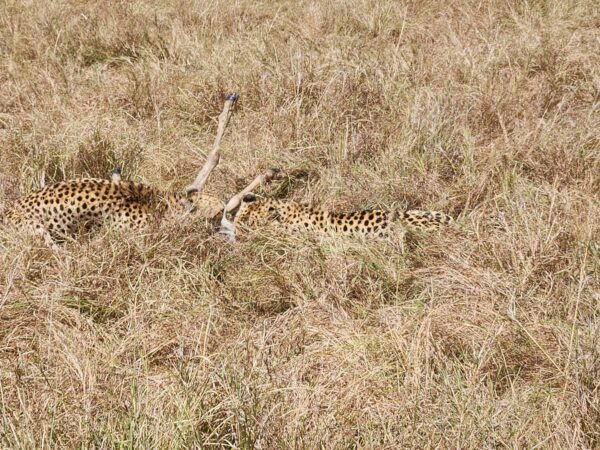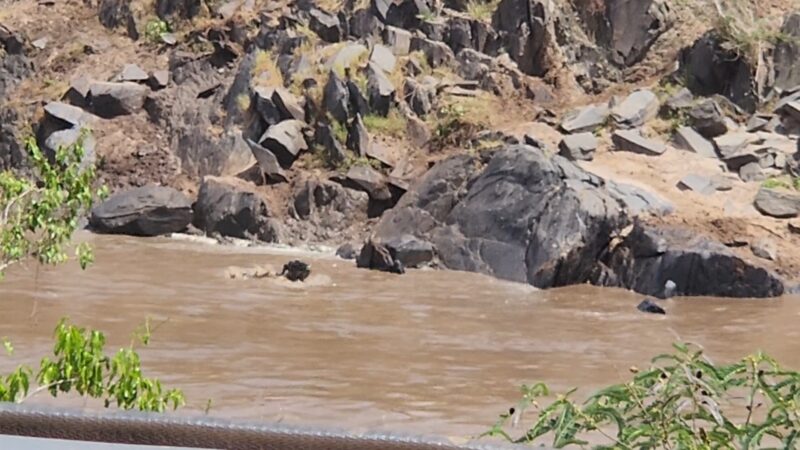Fall 2024
The Great Migration: Lessons from the Wildebeest
 Dawn Stevens, Comtech Services
Dawn Stevens, Comtech Services
In August, I was fortunate to return to Kenya, having last visited in February and March of 2023.[1] While there, I once again had the opportunity to go on safari for a couple of days. This time, being later in the year, I was lucky enough to be there for the annual wildebeest migration. In contrast to my previous visit where I saw a very limited number of wildebeest on safari, everywhere I looked on my recent trip I saw massive herds: thousands upon thousands of the creatures.
 Wildebeest mill about on the banks of the Mara River contemplating crossing.
Wildebeest mill about on the banks of the Mara River contemplating crossing.
Wildebeest typically inhabit the Serengeti plains of southeast Africa, grazing in the savannas and woodlands that straddle the nations of Tanzania and Kenya. During the great migration, an estimated 1.5 million wildebeest travel in a 300-mile migration loop, at about 6 miles a day, searching for fresh grass and water. It is the largest land migration of mammals in the world, and truly a spectacular sight to witness.
Always searching for lessons that can be applied to our industry, I observed that the wildebeest migration is not without parallels to content migration.
 The crossing begins!
The crossing begins!
Always searching for lessons that can be applied to our industry, I observed that the wildebeest migration is not without parallels to content migration.
Although more than a million wildebeest ultimately take part in the migration, it is not all at one time, in one mass crossing. Wildebeests move in herds, which all ultimately follow the same migration pattern, but at different speeds and in slightly different directions over several months.
In contrast, it is also important to note that no wildebeest crosses alone or even in a small family group. There is strength in numbers. In fact, alone, separated from the herd, an individual wildebeest is easily felled by a predator, but as The Lion King tragically showed, a large group of wildebeest can trample said predator. Further, while the migration might appear as a confused frenzy, recent research has shown a herd of wildebeest possesses what is known as ‘swarm intelligence’, where the animals systematically explore and overcome an obstacle as one.
In addition, contrary to popular belief, wildebeest do not migrate alone; the great migration includes zebras, eland, gazelles, and impalas as well. These animals benefit from moving together, but at the same time are not competing for the same resources. For example, zebras benefit from the wildebeest’s good sense of hearing and smell that helps to protect from predators and find food. Zebras contribute to this relationship with great eyesight to see threats, and they normally feed on the top parts of the grass or the tall grasses, allowing the wildebeest to easily access their preferred short grass.
 Wildebeest and zebra migrate together.
Wildebeest and zebra migrate together.
Similarly, the most successful content migrations are not completed in one massive, overnight effort. Instead, content is divided into smaller batches, based on common characteristics, such as product, document type, or source. These conversions then move independently, with the goal that everything arrives in the same place, but at different speeds following different paths. At the same time, however, there are efficiencies to be gained in larger conversions, costs that can be shared across a larger set of content so that no one area take the entire burden. While you might need a small pilot test for your migration, it should be carefully curated to represent a full cross-section of content that enable you to explore the obstacles that may arise during conversion to resolve those issues together so that everyone is on the same page. Where possible, you can benefit from involving other groups or departments in the migration effort, who might clear the way or provide insight that you might otherwise miss.
Interestingly, wildebeest have no natural leader. It is not a dominant male or matriarch that directs the wildebeest herd across the river. Any individual animal with enough guts can start the stampede. It’s a heartening reminder that a single act on our part, even as a lone technical writer, can start a push in the right direction.
Content migration can also seem threatening; authors fear what lurks on the other side. Will the new system truly be better, or does the grass just seem greener? Left to our own devices, we may try to get by with the limitations of what we know, and it is only the action of a brave leader or a severe threat or hunger that rallies us across to the other side.
Our safari guide explained that it is difficult to predict when the migration will begin. Herds may stay on one side of the river for days, desiring to cross to the greener grass, but easily spooked by real or imagined threats. They fear crossing the river, as they have an innate inkling that something lurks there. Indeed, we sat along with dozens of other jeeps for several hours observing the tentative fits and starts of the animals contemplating the crossing before one brave soul finally committed and led the others across.
Content migration can also seem threatening; authors fear what lurks on the other side. Will the new system truly be better, or does the grass just seem greener? Left to our own devices, we may try to get by with the limitations of what we know, and it is only the action of a brave leader or a severe threat or hunger that rallies us across to the other side.
Sadly, the wildebeest’s hesitance in making the river crossing is well-founded. The search for greener pastures does not come without danger. The migration kills off around 250,000 wildebeest and 30,000 zebra every year, as a result of thirst, hunger, and exhaustion, as well as crushes and drownings in stampedes of nervous animals. They face a host of mighty predators, including lions, hyenas, cheetahs, leopards, and wild dogs, and the migration route crosses many rivers, most filled with giant Nile crocodiles who prey on the young and weak animals. (One wildebeest is enough to satisfy a crocodile’s appetite for an entire year.)
Our journey gave us the opportunity to witness these dangers firsthand, including:
- Two cheetah planning and executing an attack on a herd who had not yet chosen to cross the river.
 The circle of life. Some wildebeest don’t make it.
The circle of life. Some wildebeest don’t make it.
- A crocodile lying in wait in the river until the crossing making quick work of an early crosser.
 Crocodiles drown their prey by clutching them in their strong jaws and pulling them below the water, twisting them to break off bite-size pieces.
Crocodiles drown their prey by clutching them in their strong jaws and pulling them below the water, twisting them to break off bite-size pieces.
- A leopard hiding behind rocks on the other side of the river suddenly bounding into the herd as they scrambled up the riverbank (sadly that happened too fast for the camera).
There will be casualties during content migration – hopefully not so many for the technical writer; however, migration to new tools and processes certainly does risk attrition in the staff who don’t want to or can’t make the adjustments. More certainly, however, casualties come to the content as some will be left behind or lost in the process:
- The old, outdated content that we kept for nostalgic or historical reasons, but that we no longer support.
- The non-conforming content that we conveniently ignored did not comply with our standards.
- The content untouched by user’s hands due to a lack of relevance.
- The isolated outlier that shares nothing in common with the rest of the library.
Are you planning a great migration? Moving to a new tool or architecture? Changing your work processes? Unlike the poor wildebeest, who instinctively and rightly so fears the crossing, you have more control over the situation. You can seek out guides who have made the trek before and know how to avoid the hazards. Comtech is happy to be your safari guide, helping you to anticipate and predict where the predators lie in wait and put processes in place to counter them. Where losses are required, we can help you choose what to sacrifice, employing calculated and intentional selection, rather than natural selection, and yielding in the long run, a stronger herd, a more resilient content corpus.
_________________________
[1]I work with a charitable organization, Champions of Women’s Hope, which focuses on helping teenage girls stay in school by providing for basic needs that would otherwise force them to miss multiple days each month due to simple biology. If you’re interested in learning more, private message me.
About the Author:
Dawn Stevens is CIDM’s Director and President of Comtech Services. She has over 30 years of practical experience in virtually every role within a documentation and training department including project management, instructional design, writing, editing, and multimedia programming.

